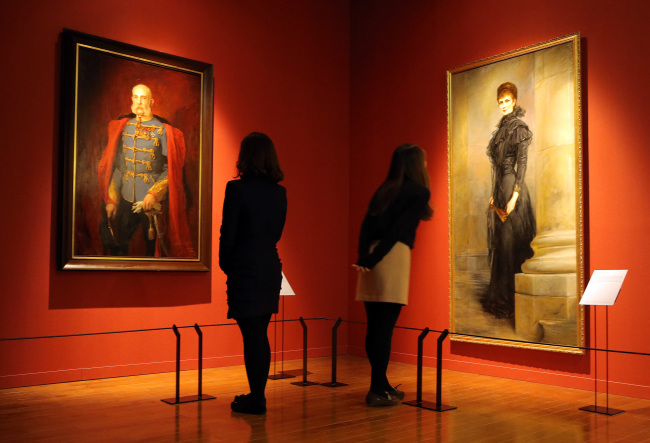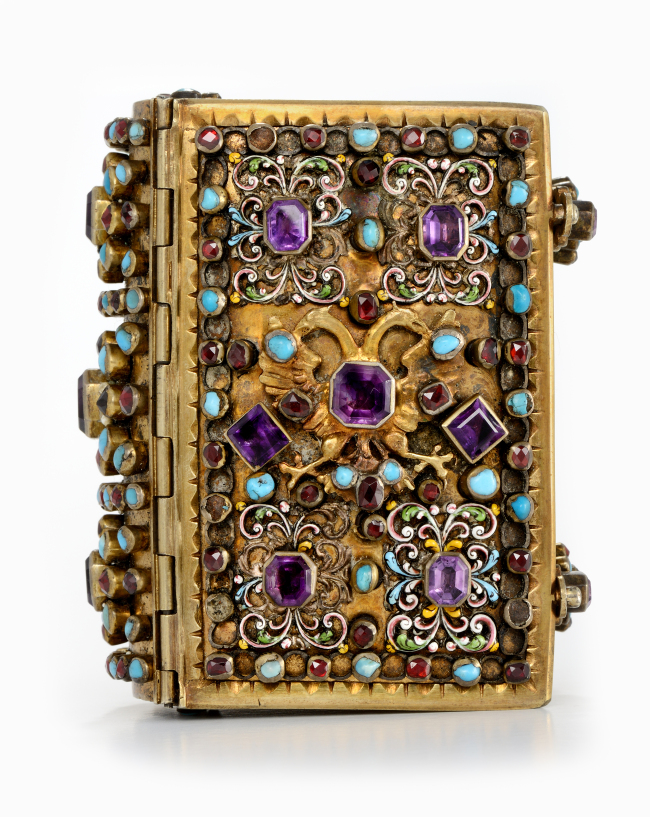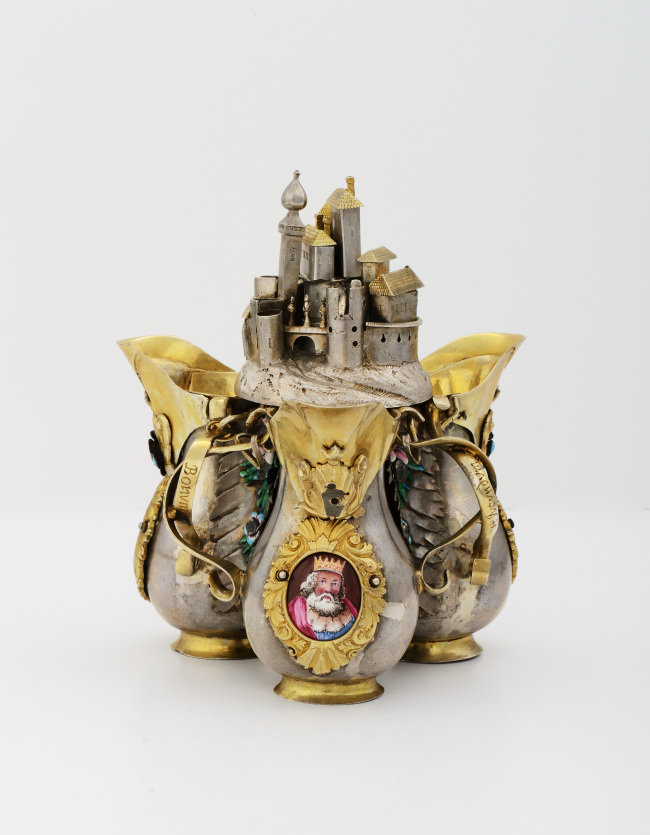Glory and sophistication of Hungary
Exhibitions in Seoul and Daegu highlight life of Hungarian aristocracy under the Habsburg Dynasty
By Korea HeraldPublished : Dec. 2, 2013 - 19:35

The east European country of Hungary has been a large melting pot over the centuries. Since the founding of the country in A.D. 1000, the country has been invaded by Mongolians, Turks and Austrians, resulting in a unique culture of its own.
The National Palace Museum is holding an exhibition titled “Magnificent Life of Hungarian Aristocracy under the Reign of the Habsburg Dynasty, in the 17-19th Century,” featuring a total of 190 items from the National Museum of Hungary. From a replica of the Holy Crown to a gala dress, headdress, armor and paintings, each piece shows the extravagance and glory of the country that once spanned across today’s Romania and Yugoslavia.
Adversity and glory

In the middle of the 17th century, the Habsburgs, the most powerful family in Europe at the time, came to completely rule over Hungary, which had been under 150 years of Ottoman Empire rule. Aristocrats first resisted, but most of their struggles were futile and people were slowly assimilated to the monarchy.
During 17th-19th centuries, Hungarian nobles were influenced by the Habsburgs, but at the same time they tried to protect their customs by wearing Hungarian traditional clothes at major state events or ceremonies.
The Holy Crown, used at coronation ceremonies, was at the center of such endeavors. The crown was believed to have been worn by St. Stephen I, the founder of Hungary, in around 1000. During World War II, the crown was sent to Fort Knox of the U.S. for safe keeping and returned to Hungary in 1978. A replica is on display at the Seoul exhibition while the original remains at the Hungarian Parliament. Paintings of the crown and coronation insignia are also on display.
The nobility wore Hungarian traditional attire or costumes that are inspired by traditional fashion. The women’s gala dress, which was worn by Stefania Prandau, has embroidery of flowers and leaves. The wife of Count Majlath Gyorgy wore the red velvet bodice, an apron (which was part of Hungarian women’s formal dress) and a headdress that covered the entire back. Men wore skin-tight pants and equally tight-fitting boots paired with colorful coats.
During 17th-19th centuries, Hungarian nobles were influenced by the Habsburgs, but at the same time they tried to protect their customs by wearing Hungarian traditional clothes at major state events or ceremonies.
The Holy Crown, used at coronation ceremonies, was at the center of such endeavors. The crown was believed to have been worn by St. Stephen I, the founder of Hungary, in around 1000. During World War II, the crown was sent to Fort Knox of the U.S. for safe keeping and returned to Hungary in 1978. A replica is on display at the Seoul exhibition while the original remains at the Hungarian Parliament. Paintings of the crown and coronation insignia are also on display.
The nobility wore Hungarian traditional attire or costumes that are inspired by traditional fashion. The women’s gala dress, which was worn by Stefania Prandau, has embroidery of flowers and leaves. The wife of Count Majlath Gyorgy wore the red velvet bodice, an apron (which was part of Hungarian women’s formal dress) and a headdress that covered the entire back. Men wore skin-tight pants and equally tight-fitting boots paired with colorful coats.

The table fountain assumed to have been created for Ferenc Andrassy in 1748 is a composition of three jugs with their backs to each other. The partly silver-gilt, painted enamel tableware shows the sophistication of Hungarian arts, said Park Soo-hee, curator of the event.
Kings and queens
Queen Maria Theresia (1717-1780) gained respect and loyalty from Hungarian aristocrats but after her death, calls for independence soared and in 1867, the Habsburg Dynasty proclaimed a “Compromise,” making peace with Hungary and recognizing it as an equal partner in the political, diplomatic and military spheres.
Behind the great improvement was Queen Elizabeth (1837-1898), also known as Sissi, who was famous for her beauty. The queen reportedly showed interest in Hungary from an early stage, joining hands with local intellects and convinced her husband, King Franz Joseph (1836-1916), to make the decision. The queen has been one of the most popular royals of all time, with scores of paintings dedicated to praise her beauty and courage.
“To many of us, Hungary is just a country known for the beautiful capital city Budapest, and some classical music pieces such as ‘Hungarian Rhapsody.’ We hope the exhibition could bring people closer to Hungary with its unique and beautiful culture,” said Lee Gwi-young, director of the museum, on Monday, a day before the opening of the event.
The exhibition will be held at the National Palace Museum through March 9. It will move to Haengso Museum of Keimyung University in Daegu, from April 1 through June 14. For more information visit www.gogung.go.kr.
By Bae Ji-sook (baejisook@heraldcorp.com)
Kings and queens
Queen Maria Theresia (1717-1780) gained respect and loyalty from Hungarian aristocrats but after her death, calls for independence soared and in 1867, the Habsburg Dynasty proclaimed a “Compromise,” making peace with Hungary and recognizing it as an equal partner in the political, diplomatic and military spheres.
Behind the great improvement was Queen Elizabeth (1837-1898), also known as Sissi, who was famous for her beauty. The queen reportedly showed interest in Hungary from an early stage, joining hands with local intellects and convinced her husband, King Franz Joseph (1836-1916), to make the decision. The queen has been one of the most popular royals of all time, with scores of paintings dedicated to praise her beauty and courage.
“To many of us, Hungary is just a country known for the beautiful capital city Budapest, and some classical music pieces such as ‘Hungarian Rhapsody.’ We hope the exhibition could bring people closer to Hungary with its unique and beautiful culture,” said Lee Gwi-young, director of the museum, on Monday, a day before the opening of the event.
The exhibition will be held at the National Palace Museum through March 9. It will move to Haengso Museum of Keimyung University in Daegu, from April 1 through June 14. For more information visit www.gogung.go.kr.
By Bae Ji-sook (baejisook@heraldcorp.com)
-
Articles by Korea Herald







![[Graphic News] More Koreans say they plan long-distance trips this year](http://res.heraldm.com/phpwas/restmb_idxmake.php?idx=644&simg=/content/image/2024/04/17/20240417050828_0.gif&u=)
![[KH Explains] Hyundai's full hybrid edge to pay off amid slow transition to pure EVs](http://res.heraldm.com/phpwas/restmb_idxmake.php?idx=644&simg=/content/image/2024/04/18/20240418050645_0.jpg&u=20240419100350)






![[From the Scene] Monks, Buddhists hail return of remains of Buddhas](http://res.heraldm.com/phpwas/restmb_idxmake.php?idx=652&simg=/content/image/2024/04/19/20240419050617_0.jpg&u=20240419175937)

![[KH Explains] Hyundai's full hybrid edge to pay off amid slow transition to pure EVs](http://res.heraldm.com/phpwas/restmb_idxmake.php?idx=652&simg=/content/image/2024/04/18/20240418050645_0.jpg&u=20240419100350)

![[Today’s K-pop] Illit drops debut single remix](http://res.heraldm.com/phpwas/restmb_idxmake.php?idx=642&simg=/content/image/2024/04/19/20240419050612_0.jpg&u=)